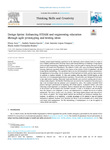Mostrar o rexistro simple do ítem
Design Sprint: Enhancing STEAM and Engineering Education Through Agile Prototyping and Testing Ideas
| dc.contributor.author | Arce Fariña, Elena | |
| dc.contributor.author | Suárez-García, Andrés | |
| dc.contributor.author | López-Vázquez, José-Antonio | |
| dc.contributor.author | Fernández-Ibáñez, Isabel | |
| dc.date.accessioned | 2022-06-28T07:51:59Z | |
| dc.date.available | 2022-06-28T07:51:59Z | |
| dc.date.issued | 2022-06 | |
| dc.identifier.citation | Arce, Elena, Andrés Suárez-García, José Antonio López-Vázquez, y María Isabel Fernández-Ibáñez. «Design Sprint: Enhancing STEAM and Engineering Education through Agile Prototyping and Testing Ideas». Thinking Skills and Creativity 44 (junio de 2022): 101039. https://doi.org/10.1016/j.tsc.2022.101039 | es_ES |
| dc.identifier.issn | 1871-1871 | |
| dc.identifier.uri | http://hdl.handle.net/2183/31011 | |
| dc.description.abstract | [Abstract] Creating project-based learning experiences in the classroom where students learn in a team to solve complex problems and to develop creative and critical thinking is a challenge. Design Sprint (DS) is an agile methodology (implemented in 5 days) with the goal of creating innovative design based on user needs (User Experience). The objective of this work was to develop an Engineering Drawing classroom experience linked to the context of the current COVID-19 pandemic with the Design Sprint methodology. The experience had to involve the integration of theory and practice, the application of knowledge, the development of both hard and soft skills, and the empowerment of students to conduct research. 56 first-year students following three STEAM degrees at the University of A Coruña participated in this experience. The activities were designed for both face-to-face and remote learning. Microsoft Teams and Moodle were used for tutoring and for monitoring student progress. The Moodle Workshop tool was used for the evaluation of the prototypes that were developed and the projects were evaluated by video. The students defended their projects through a presentation in lightning talk format (Ignite). Evaluation rubrics were used following a triple approach: co-evaluation, hetero-evaluation and self-evaluation. The 3D design of the projects was developed with Autodesk software. A total of 18 projects were developed. Once the projects were completed, a survey was administered to evaluate the levels of student satisfaction. The survey results were very positive. The Design Sprint projects also showed positive effects on grades. The Design Sprint method has promoted an interactive learning environment. In addition to its simplicity, a further advantage of DS method is that all student dedication is planned. Students were therefore less likely to feel overloaded, all of which helps with better time management. The DS methodology is multipurpose, so it can be applied to various fields and subjects. | es_ES |
| dc.language.iso | eng | es_ES |
| dc.publisher | Elsevier | es_ES |
| dc.relation.uri | https://doi.org/10.1016/j.tsc.2022.101039 | es_ES |
| dc.rights | Attribution 4.0 International (CC BY 4.0) | es_ES |
| dc.rights.uri | https://creativecommons.org/licenses/by/4.0/ | * |
| dc.subject | Design Sprint | es_ES |
| dc.subject | STEAM | es_ES |
| dc.subject | 21st century abilities | es_ES |
| dc.subject | Evaluation methodologies | es_ES |
| dc.subject | Teaching strategies | es_ES |
| dc.title | Design Sprint: Enhancing STEAM and Engineering Education Through Agile Prototyping and Testing Ideas | es_ES |
| dc.type | info:eu-repo/semantics/article | es_ES |
| dc.rights.access | info:eu-repo/semantics/openAccess | es_ES |
| UDC.journalTitle | Thinking Skills and Creativity | es_ES |
| UDC.startPage | 1 | es_ES |
| UDC.endPage | 14 | es_ES |
| dc.identifier.doi | 10.1016/j.tsc.2022.101039 |
Ficheiros no ítem
Este ítem aparece na(s) seguinte(s) colección(s)
-
GI-CTC - Artigos [67]






